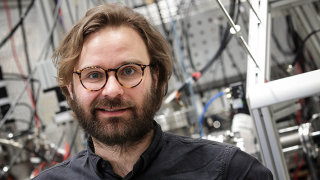Dissertation: New laser spectroscopy device strengthens nuclear physics research in Jyväskylä (Kujanpää)

A central aim in nuclear physics is to understand the structure of exotic, short-lived nuclei that do not occur naturally on Earth. These rare forms of matter provide insight into the forces and behaviours that govern the building blocks of atoms.
- Studying such nuclei can reveal unique phenomena, such as changes in nuclear shape and shell structure, that are not seen in stable isotopes. Experimental measurements of nuclear properties are used to refine nuclear models for a better understanding of the atomic nuclei and to make predictions of nuclei that currently cannot be synthesized in laboratories, explains Doctoral Researcher Sonja Kujanpää from the Department of Physics.
Laser spectroscopy is an effective method for studying atomic nuclei
One of the most effective tools for this kind of research is laser spectroscopy, which uses laser light tuned to the transition frequency between electronic levels in atoms and ions, to measure the electromagnetic properties of atomic nuclei.
- These measurements can determine nuclear spin, magnetic and electric moments, and changes in nuclear size. However, the effects being measured are extremely small, requiring highly precise and sensitive methods, tells Kujanpää.
New perspectives on the core map
A doctoral thesis work of M.Sc. Sonja Kujanpää has developed and commissioned a new laser spectroscopy setup, called RAPTOR (Resonance Ionisation Spectroscopy and Purification Traps for Optimized spectRoscopy), at the IGISOL facility of the Accelerator Laboratory in Jyväskylä.
- The setup is designed to employ the technique of Collinear Resonance Ionization Spectroscopy (CRIS), originally pioneered at ISOLDE-CERN, and allows the optical study of isotopes produced in very small quantities. RAPTOR is also foreseen to provide purified ion beams for other experiments such as the JYFLTRAP double Penning trap, says Kujanpää.
By enabling high-precision optical measurements of isotopes that are traditionally difficult to produce elsewhere, RAPTOR will strengthen the ability of the IGISOL facility to address questions about how atomic nuclei change across the nuclear chart.
- The method can be applied to fundamental research in nuclear physics and may also support future developments in areas such as ultra-trace analysis, tells Kujanpää.
The dissertation also includes measurements performed at the CRIS experiment at CERN, where a similar method was used to study a long chain of radioactive silver isotopes.
- The results provided detailed information on the changes in size and shape of these nuclei, which helps test and refine theoretical models of nuclear structure, explains Kujanpää.
M.Sc. Sonja Kujanpää will defend her doctoral dissertation “Development and application of collinear resonance ionization spectroscopy: RAPTOR at IGISOL and the study of 106-123$Ag at ISOLDE-CERN” on Friday 26.9.2025 at 12:00 in the lecture hall FYS1 on Ylistönrinne. The opponent is Doctor Thomas Day Goodacre (University of Manchester) and the custos Docent Mikael Reponen (University of Jyväskylä). The language of the dissertation is English.
Dissertation “Development and application of collinear resonance ionization spectroscopy: RAPTOR at IGISOL and the study of 106-123$Ag at ISOLDE-CERN” is available in the JYX-digital archive: https://urn.fi/URN:ISBN:978-952-86-0987-2
Further information:
- Doctoral Researcher Sonja Kujanpää, sonja.p.kujanpaa@jyu.fi







